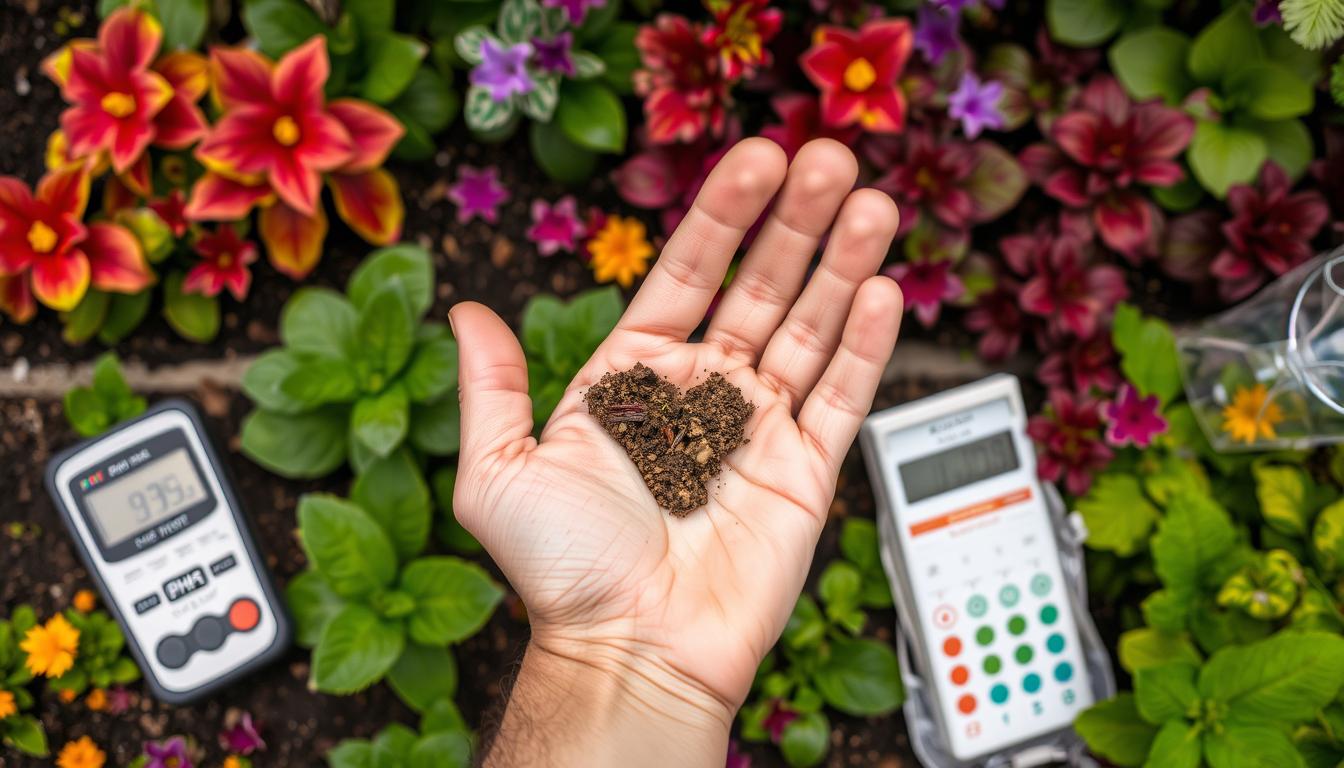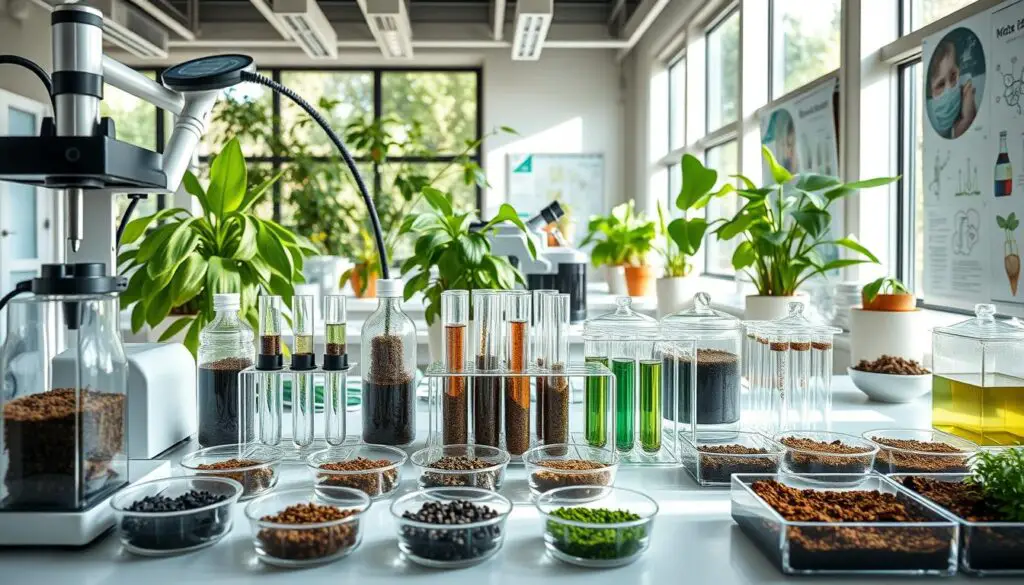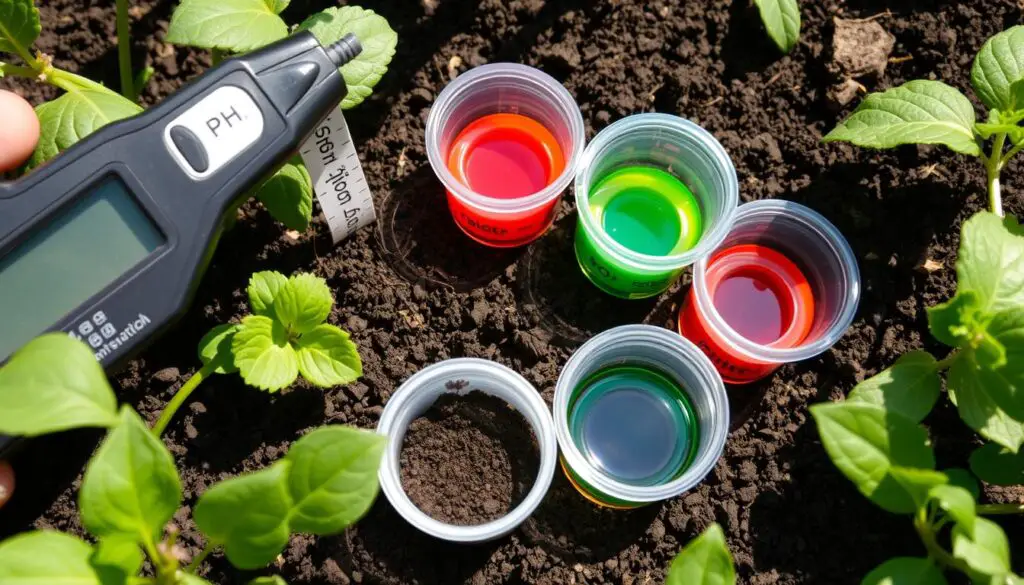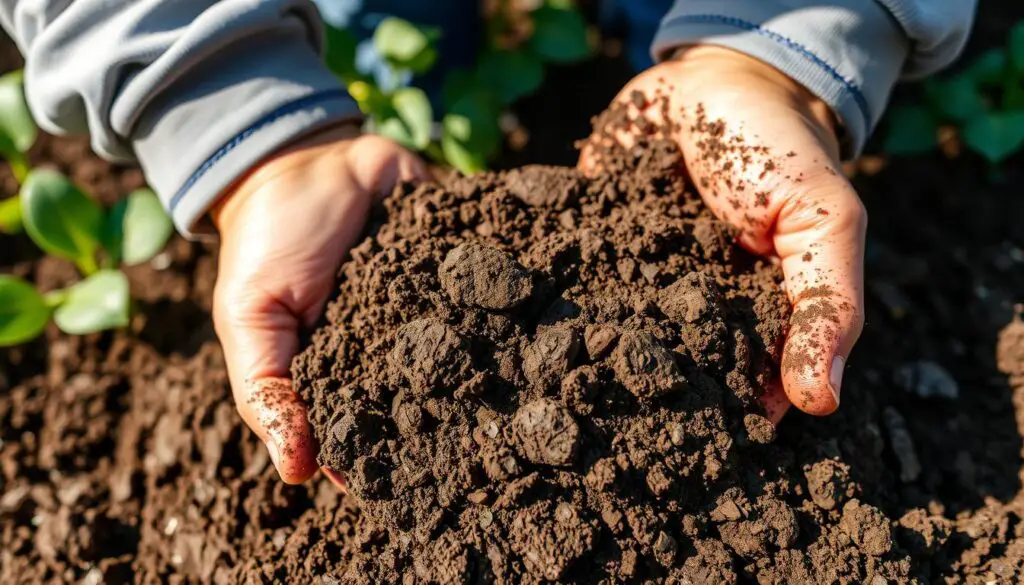How to Test Soil for Nutrient Deficiencies

Did you know most gardens and landscapes lack nutrients in the soil?
Almost 75% of American homeowners forget to test their soil regularly.
This can lead to poor plant growth and health. As a gardener, I’ve learned how crucial it is to know your soil’s health.
In this guide, I’ll show you how to test your soil for nutrient gaps. We’ll cover everything from preparing your sample to understanding the results. Whether you choose a lab test or a DIY kit, knowing your soil’s makeup helps you improve your garden. Let’s get started!
Key Takeaways
- Soil testing is key to finding nutrient gaps and improving plant growth.
- Professional soil analysis is often free or cheap and offers detailed insights.
- DIY soil tests can give a basic idea of your soil’s texture, pH, and health before a lab test.
- Healthy soil has a mix of 20% clay, 40% silt, and 40% sand.
- Keeping your soil pH between 5.5 and 7 helps plants absorb nutrients better.
How to Test Soil for Nutrient Deficiencies
Knowing what’s in your soil is key for healthy plants. Soil gives plants the nutrients, water, and air they need. Testing your soil helps find any missing nutrients or imbalances. This lets you fix your soil to help plants grow better.
Understanding Soil Composition
Soil is made up of minerals, organic matter, water, and air. The mix of these things affects how well your soil works. Things like texture, pH, and nutrients like nitrogen and potassium are important for plants.
Identifying Nutrient Imbalances
Soil tests show if your soil lacks nutrients. Knowing what nutrients are missing helps you choose the right fertilizers. This way, you avoid wasting money and make sure plants get what they need.
“A soil test is the initial step in planning a nutrient management program for optimal crop production, environmental protection, and cost savings.” – Sam, author of the blog
Preparing Your Soil Sample
Getting a good soil sample is key to knowing what your garden needs. As a gardener, I know how important it is to test your soil. By following a few easy steps, you can get a true picture of your garden’s health.
To start, soil sampling means taking samples from different spots in your garden. For big areas like yards, take 10-15 cores. For smaller spots, like beds or shrubs, take 4-6 cores. Make sure to dig 6-8 inches deep for gardens and 3 inches for lawns.
- Collect soil from different parts of your garden, including any special spots.
- Mix the samples together in a clean container to get a single sample.
- Let the mix dry out on a surface or in a box.
- Break up any clumps and remove any debris or rocks.
- Put about 1 pint of the soil sample in a clean container to send for testing.
It’s important to collect your soil sample right to get accurate results. By getting a good sample, you’ll know what nutrients your soil needs. This helps you choose the right fertilizers and amendments for your garden.
“Accurate soil testing starts with proper sample collection. Taking the time to gather a representative sample will provide you with the information needed to achieve optimal plant growth.”- Laura, lawn health specialist
With a bit of prep, your soil testing will give you the insights you need for a healthy garden. By following these steps, you’ll understand your soil’s makeup. This knowledge helps you make choices that support your plants’ health and growth.
Finding a Soil Testing Lab
Understanding your soil’s health and nutrient levels is key. Sending a sample to a soil testing lab can give you valuable insights. These labs use advanced methods and equipment to analyze your soil. They provide a detailed report that helps with gardening and landscaping.
Benefits of Professional Soil Analysis
A professional soil analysis from a trusted lab has many benefits:
- Detailed nutrient levels: Labs can measure essential nutrients like nitrogen, phosphorus, and potassium. They help find any imbalances or deficiencies.
- Accurate pH assessment: Knowing your soil’s pH is vital for plant growth. Labs provide precise pH measurements.
- Comprehensive reporting: Reports include nutrient levels, pH, soil texture, organic matter, and contaminants.
- Customized recommendations: Based on the results, labs offer specific advice for soil amendments and fertilization.
The cost of soil testing services varies. Basic tests cost between $11 and $30, plus mailing. More detailed tests cost more. Always check with the lab for current prices before sending your sample.

A professional soil analysis gives you the knowledge to improve your soil. This leads to healthier plants and a more vibrant garden or landscape.
Doing Your Own Soil Tests
For gardeners who love to get their hands dirty, there are easy DIY soil tests you can do at home. These tests help you understand your soil’s physical properties. They guide you in choosing the right amendments for your garden.
Soil Texture Test
The soil texture test is simple. Just squeeze a soil sample to see what it’s made of. This tells you if your soil is sandy, clay-based, or a mix of both, known as loam. The best mix for plants is 40% sand, 40% silt, and 20% clay.
Soil Drainage Test
The soil drainage test shows how fast water moves through your soil. It’s key for aeration and keeping nutrients. This DIY test spots any drainage problems in your garden or lawn.
To do these tests, you’ll need a trowel, a clear container, and water. By doing these simple tests, you learn a lot about your soil. This knowledge helps you make smart choices about what to add to your soil and how to care for it.
| Soil Type | Texture Test | Drainage Test | Recommended Amendments |
|---|---|---|---|
| Sandy Soil | Gritty and loose, does not hold shape when squeezed | Water drains quickly, soil dries out rapidly | 2 inches of organic matter in the top 6-12 inches |
| Clay Soil | Smooth and sticky, forms a ball that holds its shape | Water drains slowly, soil remains wet for extended periods | Equal parts sand and compost mixed in the top 6-12 inches |
| Loam Soil | Balanced texture, forms a ball that crumbles easily | Water drains at a moderate pace, soil maintains consistent moisture | No amendments needed, soil is well-balanced |
By doing these DIY soil tests, you learn a lot about your soil. This knowledge helps you choose the best amendments and care for your plants.
pH Soil Testing
Knowing your soil’s pH is key to a healthy garden. The pH level shows if your soil is acidic or alkaline. It affects how well plants get the nutrients they need.
Decoding Soil pH: The Acidity-Alkalinity Spectrum
The pH scale goes from 0 to 14, with 7 being neutral. Soils with a pH below 7 are acidic, and those above 7 are alkaline. Most plants do best in slightly acidic soil, with a pH of 6.0 to 7.0. But, some like blueberries and rhododendrons need more acidic soil, with a pH of 4.5 to 5.5.
Keeping the right soil pH is important. A pH imbalance can cause nutrient problems, affecting plant growth and health.
Testing Your Soil’s pH: DIY or Professional?
You can test your soil’s pH with a DIY kit or send a sample to a lab. DIY kits are quick but might not be as accurate. Sending a sample to a lab gives a detailed analysis and advice on adjusting the pH if needed.
“Soil pH is the foundation of a healthy garden. By understanding your soil’s pH, you can unlock the full potential of your plants and create a thriving, vibrant outdoor oasis.” – Sam, lawn specialist

When you collect a soil sample, follow the lab’s instructions closely. This means taking samples from different parts of your garden, mixing them, and drying the soil before sending it. This ensures accurate results for your soil management.
Distinguishing Soil Types
Knowing the soil types in your area is key for a healthy garden or lawn. Soils fall into three main types: sandy, clay, and loam. Each type affects how plants grow and thrive differently.
Sandy Soil Characteristics
Sandy soil drains well but lacks nutrients. It has large particles that let water flow easily. Yet, it struggles to hold moisture and nutrients for plant growth.
Clay Soil Characteristics
Clay soil is rich in nutrients but can be compacted and waterlogged. Its fine particles block air and water flow. Despite being fertile, it needs careful handling to avoid drainage and compaction problems.
Loam Soil Characteristics
Loam soil is the best mix of sandy and clay soils. It has the right balance for drainage, nutrient retention, and aeration. Gardeners and landscapers love it for supporting many plants.
| Soil Type | Composition | Characteristics |
|---|---|---|
| Sandy | High in sand, low in silt and clay | Well-draining, low in nutrients |
| Clay | High in clay, low in sand and silt | Nutrient-rich, prone to compaction and poor drainage |
| Loam | Balanced mixture of sand, silt, and clay | Optimal for plant growth, good drainage and nutrient retention |
“Understanding the unique properties of different soil types is the first step towards creating a thriving garden or landscape.” – Richard, ecology professional
Knowing the traits of sandy, clay, and loam soil helps you improve your soil. You can choose the right plants and practices for your garden to flourish.
The Squeeze Test
Try the “squeeze test” for a quick look at your soil’s texture and composition. This DIY test involves taking moist soil, squeezing it, and watching how it acts. By seeing how the soil feels, you can learn a lot about its underlying composition.
Here’s how to do the squeeze test:
- Get a small amount of moist soil from your garden.
- Squeeze the soil gently in your hand and see how it reacts.
- If it falls apart easily and feels gritty, it’s sandy soil. Sandy soil drains fast.
- If it forms a sticky ball, it’s clay soil. Clay soil keeps moisture well.
- If it holds together but crumbles with a poke, it’s loamy soil. Loam is a mix of sand, silt, and clay, perfect for plants.
The squeeze test is a simple way to check your soil’s texture assessment and composition analysis. This DIY method helps you understand your garden’s soil. It lets you make smart choices to improve the soil for your plants.

“The squeeze test is a quick and easy way to get a feel for your soil’s texture, which can provide valuable insights into its composition and nutrient-holding capacity.” – Laura, lawn care enthusiast
Knowing your soil type helps you fix any problems. You can fix nutrient imbalances or drainage issues. This ensures your plants grow well. The squeeze test, along with other DIY soil testing methods, is a great tool for gardeners.
Testing Soil Chemistry
Discovering your garden’s growth potential begins with understanding its soil chemistry. The soil pH level, a measure of acidity or alkalinity, is key. Most plants prefer slightly acidic to neutral soil, with a pH between 6.0 and 7.0.
Soil pH Levels
Testing your soil’s pH can reveal important information. It shows if your soil is too acidic or alkaline. Knowing this helps you adjust the soil for your plants’ best growth.
For a detailed look at your soil’s chemistry, consider a professional soil analysis. This test shows nutrient levels and micronutrients like iron and zinc. With this info, you can feed your plants what they need.
“Soil testing is the foundation for making wise decisions about fertilizers, amendments, and other management practices.”
Whether you test your soil yourself or get a professional analysis, knowing your soil’s chemistry is vital. The right soil pH and addressing acidity or alkalinity issues create a perfect growing space. Your plants will thank you.

Using Soil Test Kits
As a gardener, I know how key it is to know my soil’s makeup. While lab tests offer detailed insights, soil test kits let me check my soil at home. These DIY soil testing kits come with test strips or solutions. They help me measure pH, nutrients, and texture without a lab.
Using at-home soil analysis kits is super convenient. I can quickly take a sample, follow the steps, and learn about my soil’s state. This info is crucial for choosing the right soil fixes for my plants.
- The UNH soil testing service handles hundreds of tests yearly, showing their widespread appeal.
- Home garden soil test kits cost between $10 and $60, making them budget-friendly for gardeners.
- Soil pH is rated from 0 to 14, with 7 being neutral. Most plants thrive in a pH of 6.2 to 7.0.
| Soil Type | Optimal pH Range |
|---|---|
| Vegetables | 6.5 – 6.8 |
| Blueberries | 4.5 – 5.0 |
Though not as detailed as lab tests, DIY soil tests offer useful info. They help me grasp my soil’s basics and what it needs. With a soil test kit, I start making my garden better fit my soil’s unique traits.
Adjusting Soil pH
Keeping the soil pH right is key for plants to grow well and get the nutrients they need. If your soil test shows it’s off, you can fix it.
Calculating Lime or Sulfur Amounts
Ground limestone or agricultural lime can make acidic soils more alkaline. On the other hand, adding soil sulfur can make alkaline soils more acidic. How much you need depends on your soil’s pH, type, and where you want it to be.
Soil pH is measured from 0 to 14, with 7 being neutral. Michigan soils can range from 4.5 to 8.5. This varies based on the soil’s makeup and how it’s used.
To figure out how much lime or sulfur to use, look at charts or online tools. Here’s a basic guide:
- For sandy soils, add 20 lbs. of limestone per 1,000 sq. ft. to increase pH.
- For loam soils, add 45 lbs. of limestone per 1,000 sq. ft. to increase pH.
- For clay loam soils, add 90 lbs. of limestone per 1,000 sq. ft. to increase pH.
- To lower pH, use no more than 15 lbs. of elemental sulfur per 1,000 sq. ft. Test again in 4-6 months before adding more.
Changing the pH by one point is easier than by two. This shows why regular soil care is important.
Knowing your soil’s pH and adjusting it can help your plants get the nutrients they need to grow well.
Amending Soil with Organic Matter
As a gardener, I’ve found that adding organic matter is key to soil health. It doesn’t matter if your soil is sandy, clay, or a mix. Compost, aged manure, leaf litter, and other organic materials can greatly improve it.
Organic matter boosts nutrient levels and soil structure. It also supports a healthy soil microbiome. For most plants, aim for at least 2% organic matter. Vegetable and flower beds need 5-10%.
When choosing organic matter, watch out for risks. Manure-based composts are rich in nutrients but might have weed seeds. Composts that have been fully composted at 131°F for three days are safer. They kill most diseases and weed seeds. Plant-based composts, though, offer a balanced nutrient profile with less risk of contaminants.
FAQ
What is the importance of soil testing?
How do I collect a representative soil sample?
What are the benefits of sending my soil sample to a professional lab?
What are some DIY soil tests I can perform at home?
How do I test my soil’s pH level?
How do I determine my soil type?
How can I adjust the pH of my soil?
How can I improve the overall health and fertility of my soil?
Source Links
- https://extension.oregonstate.edu/gardening/soil-compost/how-do-i-test-my-garden-soil
- https://www.almanac.com/content/3-simple-diy-soil-tests
- https://ag.umass.edu/greenhouse-floriculture/greenhouse-best-management-practices-bmp-manual/soil-testing
- https://agrilifetoday.tamu.edu/2023/06/12/why-should-i-get-my-soil-tested/
- https://www.harvestogroup.com/post/soil-testing-importance-and-benefits
- https://uwlab.webhosting.cals.wisc.edu/wp-content/uploads/sites/17/2015/09/sample_preparation.pdf
- https://extension.purdue.edu/county/vanderburgh/_media/collecting-soil-samples-for-testing-ho-71-w.pdf
- https://extension.umd.edu/resource/soil-testing-and-soil-testing-labs
- https://gardeningproductsreview.com/state-by-state-list-soil-testing-labs-cooperative-extension-offices/
- https://rootsnursery.com/three-easy-diy-soil-tests/
- https://talk.newagtalk.com/forums/thread-view.asp?tid=211261&DisplayType=flat&setCookie=1
- https://www.lowes.com/n/how-to/test-and-improve-your-soil
- https://content.ces.ncsu.edu/a-gardeners-guide-to-soil-testing
- https://www.smilinggardener.com/organic-soil-management/soil-testing-labs/
- https://agsource.com/soil-testing/
- https://deepgreenpermaculture.com/2020/07/23/three-simple-soil-tests-to-determine-what-type-of-soil-you-have/
- https://www.biologysimulations.com/post/how-to-use-the-soil-texture-triangle

